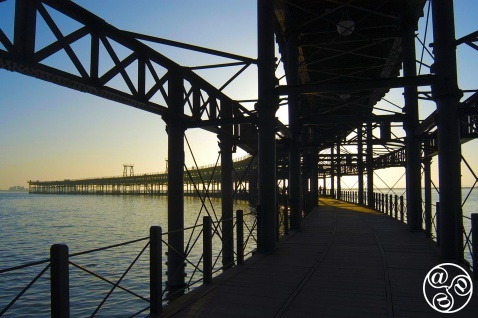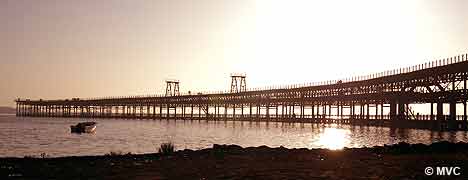
Muelle de Riotinto (Río Tinto company dock) © Michelle Chaplow |
|

THINGS TO SEE in Huelva City
Although most of Huelva's historic buildings suffered badly in the 1755 Lisbon earthquake, several pre-18th-century churches escaped destruction or were successfully restored. The most famous of these is the Sanctuario de Nuestra Señora la Virgen de la Cinta, with its links to Columbus, while the oldest is the Iglesia de San Pedro.
A stroll around the centre will reveal those monuments that were erected in response to the explosion of wealth in Huelva, injected into the local economy from the exploitation of the mines north of the city. This peaked in the late 19th-century and early 20th-century. In 1911 the art-nouveau Conservatorio de Música was inaugurated, now the Clínica Sanz de Frutos, on Calle Rico. Just round the corner on Calle Vásquez López is the Gran Teatro, with a magnificent neo-classical façade and ornate interior. This dates from 1923, when Huelva's cultural life had a big boost from foreign capital. North of the centre is the neo-Moorish Plaza de Toros, completed in the early 20th century, whose design imitates that of Las Ventas bullring in Madrid.
Other things to see in the city include the provincial museum, the Museo de Huelva, which has an excellent archaeological section. The British mining Río Tinto Company had a big impact on Huelva's 19th-century architecture, as seen in the long Muelle de Ríotinto, snaking out into the Odiel estuary, and the curious Victorian Barrio Obrero.
The Catedral de la Merced and the Iglesia de San Pedro are among the churches worth visiting.
Muelle de las Carabelas (Warf of the Caravels) is a waterfront exhibition with life-size replicas of Columbus's three ships: the Niña, the Pinta and the Santa María, built for the 500th… More →
A grave in the main Huelva cemetery holds the body of a man who changed the course of the Second World War. The strange thing is, his identity is still debated.
Huelva and its environs is a Mecca for those interested in Christopher Columbus, with a number of significant tourist attractions relating to the famous explorer. Cristóbal Colón (as he is known… More →
Museums in Huelva City: Museo de Huelva, Casa-Museo Zenobia-Juan Ramón, Museo Diocesano de Arte Sacro, Monasterio de la Rábida.
The Plaza de Toros de la Merced (bullring) was built from 1901-1902 and commissioned by architect, Trinidad Gallego Díaz, who was inspired by the bullring in Madrid, known as "the one on Calle… More →
The Gran Teatro (Great Theatre) was built by Pedro Sánchez y Núñez in 1923.It is a stately building of classic style, typical to the late nineteenth century with Second Empire decoration.
The Conservatorio Profesional de Música de Huelva "Javier Perianes" is a music centre dedicated to teaching as well as holding musical performances. It was inaugurated by the class of 1986/1987… More →
Muelle de Rio Tinto is a commercial dock used for the trade of material from the mines of the Rio Tinto Company Limited on the Rio Odiel. It is commonly known as the "Muelle del Tinto" but is no… More →
A symbol of British power in late 19th-century Huelva, the Casa Colón is the grandest of all the buildings constructed by the city's bourgeoisie around the same time. It is an imposing presence at… More →
The Barrio de Reina Victoria, otherwise known as the "Barrio Obrero" (Workers' District), is a testament to its name: an example of a Victorian English suburb superimposed onto an Andalucian… More →
This massive statue, located at Punta Sebo where the rivers Odiel and Tinto meet, is often mistaken for the figure of Columbus. The statue actually represents a Franciscan friar of Monasterio La… More →
Contemporary and graphic art are exhibited at regular exhibitions in the Sala Siglo XXI, part of the Museo Provincial de Huelva which also has remarkable displays of Tartessic, Roman and… More →
Huelva's provincial museum, housed in a modern building on the Avenida Sundheim, has an interesting archaeological collection, with objects from the megalithic sites of La Zarcita at Santa Bárbara… More →
The principal shopping streets are the narrow pedestrianized streets of Concepción, Palacio, Pérez Carasa and Berdigón and the roads leading off this main drag. Sara Merino has a good selection of… More →
Huelva's oldest parish church, the Iglesia de San Pedro, was constructed in the 15th and 16th centuries on a hilltop site of a mosque and next to the remains of a medieval fortress. It faces a… More →
This whitewashed 15th-century chapel is famous for its associations with Christopher Columbus. Positioned on El Conquero hill, about 3 km north of the city centre, it commands a wonderful view of… More →
The Iglesia de la Merced used to serve as the church of the neighbouring convent, the Convento de la Merced, and was designated a cathedral in 1953. It is one of the best examples of Baroque… More →
La Soledad hermitage on Calle Jesús de la Pasión was first erected in the early 1500s as a church for the neighbouring Hospital de la Misericordia, which was founded in 1516. From 1854 the… More →
Plaza de las Monjas can be described as the main square in the city of Huelva. Its origin is to be found during the foundation of the Convento de las Madres Agustinas; hence the name 'monjas'… More →
Atlantic Copper is a subsidiary of the North American group Freeport-McMoRan. It is the third largest copper smelter and refinery in Europe and leads domestic copper production, with a capacity of… More →
Palacio Mora Claros is an early twentieth century palace built by, Moisés Serrano and José María Pérez Carasa, and was restored in 1997.
For 'foodies' one of the best places to visit is Mercado Municipal del Carmen, which Huelva's municipal covered market. Inside, it is lined with hundreds of stalls selling all types of produce,… More →
The cemetery of Huelva was opened in 1928 and the project was initially designed by architect, Don Francisco Marín in 1907
Muelle de Tharsis is a dock showing a good example of the design and technology of the nineteenth century European avant-garde in terms of civil engineering and constituting a specialized and… More →
The Museo al Aire Libre is a contemporary open air museum which was inaugurated in May 1991 thanks to sculptor Pepe Noja who came up with the idea. It suffered a period of abandonment, with no one… More →
Muelle de Norte is one of the many docks that for part of the Port of Huelva, located within the estuary between Huelva and Palos de la Frontera. In 1969 it became the first autonomous port of the… More →
The biggest park, the vast El Conquero and adjacent Parque Moret, is crossed by Avenida Manuel Siurot, with dilapidated postmodernist sculpture decorating its viewpoints. The views over… More →
Gran Teatro
Regular plays, concerts, opera and a weekly cinema evening showing films in O.V. More >
Paseo Maritimo de la Ría
Paseo Maritimo de la Ría is a seaside boulevard that was opened in July 2016 and is within the Paraje Natural de las Marismas del Odiel.
More >
MUELLE DE RIO TINTO
Industrial architecture from this mining boom includes the various quays in the port area constructed by Rio Tinto Company Ltd for loading their minerals onto ships. Still standing are the 1,165-metre-long Muelle de Rio Tinto, which was opened on 23 de marzo de 1876 after two year work. Minerals were brought from the Rio Tinto mines by mining train which ran down the pier so that minerals could be loaded directly ont ocean going ships. It was last used in May 1975, and lay idle until it was restored in 2003;
Other remnants of British presence in the city of Huelva in the late 19th-century include the workers' district Barrio de Reina Victoria and the grand Casa Colón. Tharsis (1871) and Muelle de Norte (1908), still somewhat dilapidated. The impressive neo-Moorish Estación de Sevilla was built by the British in 1880, along with the railway used by the mining companies.
COLUMBUS
A huge monument of Christopher Columbus, the Monumento a la Fe Descubridora, (monument to the discovers faith) was inaugurated in 1929 and is symbolically situated at the Punta de Sebo, south of the centre, overlooking the confluence of the Odiel and Tinto rivers. Find out about the other atraction relating to Christopher Columbus that can be seen nearby.